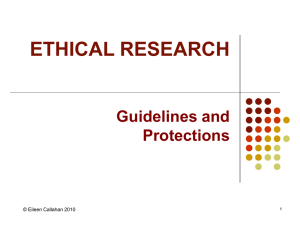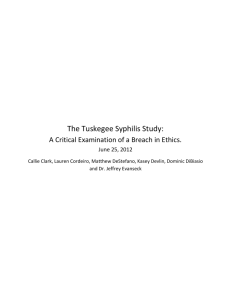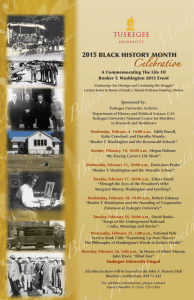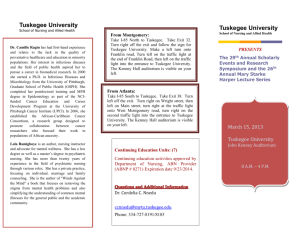Research Ethics 1, The Tuskegee Study
advertisement
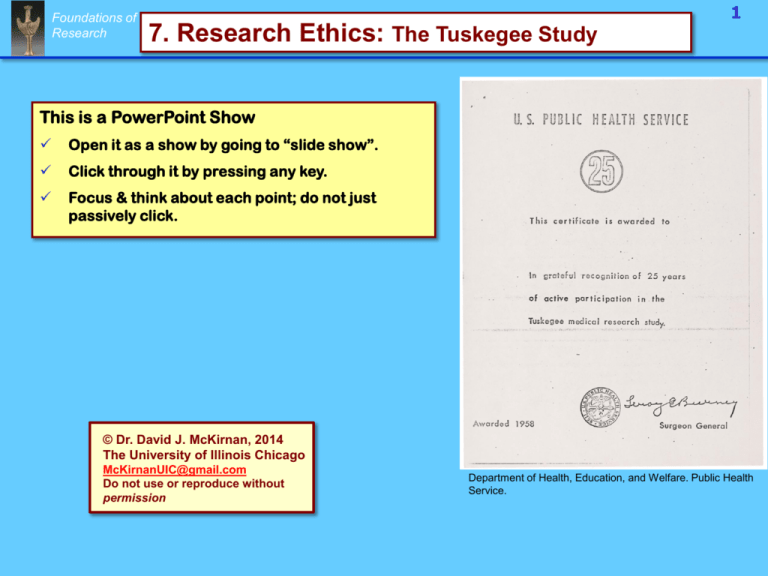
Foundations of Research 1 7. Research Ethics: The Tuskegee Study This is a PowerPoint Show Open it as a show by going to “slide show”. Click through it by pressing any key. Focus & think about each point; do not just passively click. © Dr. David J. McKirnan, 2014 The University of Illinois Chicago McKirnanUIC@gmail.com Do not use or reproduce without permission Department of Health, Education, and Welfare. Public Health Service. Foundations of Research Tuskegee & the Natural History of Syphilis 2 We will center our ethics discussion on the Tuskegee study of the “Natural history” of untreated syphilis. The aftermath of Tuskegee led to many of the ethical standard and procedures in place today. This includes reviewing the ethical standards of all studies through an Institutional Review Board. Participants in the Tuskegee Syphilis Study. Department of Health, Education, and Welfare. Public Health Service. Health Services and Mental Health Administration. Center for Disease Control. Venereal Disease Branch (1970 - 1973). Foundations of Research The Tuskegee study began as a potentially important treatment trial. Became a “Natural history” of untreated syphilis Natural History studies… Monitor disease as it emerges & changes. Crucial to understanding disease progression Typically address: Natural progression in morbidity & mortality Individual differences in progression Variables that confer vulnerability / resistance to disease progression. Data on African-American syphilis progression were limited However, there were systematic Northern European data 3 Foundations of Research Tuskegee & the Natural History of Syphilis 4 Tuskegee addressed a serious public health problem: Around 1930, when the study began, the prevalence of Syphilis in poor, rural Black men was extremely high; 25% of African-American employees at a private Alabama company tested positive for syphilis Prevalence in the 5 county rural area surrounding Macon, Alabama ranged from 35% to 40%. For context, an infection rate of 5% or so is considered a “syphilis outbreak” by the CDC today. At study outset treatments were only marginally effective Mercury was one of the earliest treatments, used extensively in Europe from the Renaissance to the 1940s "A night in the arms of Venus leads to a lifetime on Mercury”. The arsenic-derived drug Salvarsan was the treatment of choice in 1930. One “folk” treatment actually consisted of drinking kerosene (!). 5 Foundations of Research A key figure in the study was Nurse Eunice Rivers, the research nurse that recruited most of the participants. Miss Evers recruited men using personal relationships, and by caring about their medical status. Participants were also attracted to free medical exams and treatment for minor ailments, rides to and from the clinics, meals, and provisions for burial stipends paid to their survivors. The latter was very important: it was stigmatizing for the family to have a pauper’s funeral. Nurse Rivers with a study participant. Department of Health, Education, and Welfare. Public Health Service, Center for Disease Control. Venereal Disease Branch (1970 - 1973). Nurse Rivers, as the only full-time employee of the study, was responsible for all day-today operations. Thus, she kept men in the study without treatment even when Penicillin became widely available. She is often portrayed as a villain in the story, given her direct role. However, this masks the much more important role of White investigators, none of whom were from the South. Her story, portrayed in the HBO film Miss Evers’ Boys, provides an overview of the study and its moral and ethical failings. Click the image for the Amazon release, or here for a (somewhat grainy) YouTube version. Foundations of Research Tuskegee & the Natural History of Syphilis 1928 – 1930: Tuskegee is begun as a prevalence and treatment study Funding: The Public Health Service (PHS, predecessor to the CDC) The Rosenwald Fund (An African-American development fund). Participants: primarily poor, uneducated, African-Americans. Stage 1: Prevalence study 7,000 – 10,000 people tested; Syphilis prevalence = 36% Stage 2: Treatment trial Salvarson & Mercury; Penicillin not yet used in general medicine. 1,200 treated by 1930. Thus, the eventual observational study was not even a true natural history: treatment was provided in the early stages. 6 Foundations of Research Tuskegee & the Natural History of Syphilis 1930 – 1932: The Depression slashes funding The treatment arm of the study is defunded. Rosenwald fund pulls out of the study Neither the PHS nor the State of Alabama have funds to continue the study. Men still followed by the Tuskegee Institute European data showed most syphilis symptoms to be physical rather than neurological. Tuskegee Investigators hypothesized that symptoms among African-Americans would be predominantly neurological. Since no coherent theory would predict this, it is a classic example of “scientific racism”. Department of Health, Education, and Welfare. Public Health Service. 7 Foundations of Research Tuskegee & the Natural History of Syphilis 8 1934: PHS funds the continuation of the Natural History study. Participants: 600 poor, African-American sharecroppers 399 participants had syphilis at study outset. Participants were told they are simply receiving medical treatment, not that they are in a research study Incentives for participation: medical care, meals, burial insurance. Not being buried as a pauper was culturally very important Of course men could only qualify for the insurance if they literally stayed in the study for the rest of their lives! Infected men not told they had syphilis. The cohort was recruited and maintained by a local AfricanAmerican, Nurse Evers. Nurse Evers cultivated personal relationships with participants, and drives them to their medical visits. Eunice Evers speaking to study participants. Department of Health, Education, and Welfare. Public Health Service. Foundations of Research 9 Tuskegee & the Natural History of Syphilis 1943: Penicillin becomes generally available. Alexander Fleming had first identified Penicillin in 1929. The treatment potential of Penicillin was recognized in 1939. Larger scale production begun by the U.S. War Production Board (WPB) in 1943, to treat “venereal disease”. Tuskegee participants not informed that treatment is available One rationalization was that penicillin may not be effective for longer-standing syphilis. There was no clear theoretical rationale for this assumption The assumption – later proved false – was not tested by giving the Tuskegee men treatment. Treatment was given only when the study was stopped. Department of Health, Education, and Welfare. Public Health Service. Foundations of Research Tuskegee & the Natural History of Syphilis 1950s - 1960s; Multiple papers published in Medical Journals describe the study. Few or no ethical questions posed to PHS or the journals 1963 1956 1935 10 Foundations of Research Tuskegee & the Natural History of Syphilis 11 1965: Dr. Irwin Schatz sends a letter to PHS (then CDC) “I am utterly astounded by the fact that physicians allow patients with a potentially fatal disease to remain untreated when effective therapy is available.” CDC files the letter, noting it was the first such letter received. No reply was written. 1966: Dr. Peter Buxtun writes CDC after reviewing published articles on Tuskegee Buxtum invited to CDC to discuss the study. CDC does not change its policy or stop the study. 1968: Buxtun again writes CDC Committee formed to investigate the study. CDC again does not change policy or stop the study. Foundations of Research Tuskegee & the Natural History of Syphilis 12 1972: Buxtun discusses the study with a reporter from the Associate Press. Jean Heller writes an explosive columns for the Washington Star (now Washington Post) and New York Times. 1972: Secretary of Health & Human Welfare (now Health & Human Services) convenes a panel … in response to the Washington Star report, not from communication from CDC. Describes himself as “shocked” and “horrified”. 1973: Sen. Ted Kennedy begins congressional hearings. Congress hears about the study for the first time, despite 40 years of government funding for it. The study ends and remaining participants given penicillin. Foundations of Research Tuskegee & the Natural History of Syphilis 1975; Class action suit brought by surviving members of the cohort. 1980s; HIV / AIDS re-invokes prospect of unethical research or treatment Incidence of HIV infections skewed toward AfricanAmericans & other minorities Search for vaccines & treatments raises the prospects of racist or unequal treatment. 1997; Presidential apology Bill Clinton apologizes to the 8 remaining cohort members. 13 Foundations of Research Core ethical issues in Tuskegee No informed consent Key issue: Research was presented as Clinical care Refusal of treatment …not informed when Penicillin became available Coercive enrollment & retention Deception: Patients unaware they were in a research study • personal relationships with Nurse Evers Exploitation: • vulnerability of uneducated, poor men with a disease Primary incentive was burial $, which would require lifetime participation Co-opted population members: Local African-American Medical Personnel were key players on the research and study team. 14 Ethical Principles stemming from Tuskegee aftermath: Foundations of Research Include participants of all races & both genders in study cohorts Members of the target population included on research team & design boards Barring a compelling reason to exclude groups. Note: African-Americans were on the research and outreach teams in Tuskegee Facilitate access to an intervention to the entire population Cannot withhold “Standard of Care”. Standard of Care shifted during the Tuskegee study – from Salvarson to penicillin – but study procedures did not. Research must contribute to population being studied Communicate research results Develop applied programs or interventions 15 Ethical Principles stemming from Tuskegee aftermath: Foundations of Research Include participants of all races & both genders in study cohorts Members of the target population included on research team & design boards Facilitate access to an intervention to the entire population Research must contribute to population being studied James Jones’ Bad Blood is an excellent history and ethical overview of Tuskegee and other studies, with particular relevance to the HIV/AIDS epidemic. Click the image for Amazon.com 16 Foundations of Research Ethics procedures stemming from Tuskegee Informed consent Non-coercive enrollment & retention Led to the 1979 Belmont Report 17 Indirectly to core elements of the “Common Rule”. Ethical review & monitoring Led to establishment of the Federal Office for Human Research Protections (OHRP) Led to laws requiring Institutional Review Boards (IRBs) All Federally funded research must be reviewed and monitored by a local IRB Most institutions (e.g., UIC) require IRB approval of all research, federally funded or not. Foundations of Research SUMMARY Begun – and should have remained – a natural history of participants’ response to treatment. Had the virtue of being conducted by a local institution – Tuskegee Institute – with African-American Investigators & staff. Became a wholly unethical no-treatment history. 18 Tuskegee study begin as a potentially valuable trial of treatment outcomes Tuskegee Study: Overview Based on spurious – and racist – scientific reasoning about differences between Africans and Caucasians Investigators took advantage of participants economic and social vulnerability to exploit and harm them. Note: Tuskegee participants were not actually given syphilis; they were not given treatment. Tuskegee led to many of our research norms and institutional controls. Foundations of Research Quiz European data showed most syphilis symptoms to be physical rather than neurological. Tuskegee Investigators hypothesized that symptoms among African-Americans would be predominantly neurological. This is an example of: A = Expanding a hypothesis to a new study B = A change in theory C = Scientific racism D = Tailoring a hypothesis to a specific culture This is potentially correct – the hypothesis did change for poor African-Americans – although it was not based on a clear scientific rationale. Rather, it derived from racist stereotypes about African-American intelligence. 19 Foundations of Research Quiz European data showed most syphilis symptoms to be physical rather than neurological. Tuskegee Investigators hypothesized that symptoms among African-Americans would be predominantly neurological. Why was this hypothesis an example of scientific racism? A = It involved an underprivileged group B = It had no theoretical or empirical rationale C = It was in the context of a coercive study D = It was never communicated to the participants Each of these unethical features may have stemmed from a racist disregard for the men in the study. The key is that any hypothesis – particularly regarding racial differences – must have a scientific basis. 20 Foundations of Research 21 Quiz Which of these was not an unethical feature of the study: A = Syphilis was not that important a health threat to the population under study. B = A lack of informed consent C = Coercive enrollment and retention practices D = Refusal of effective treatment Syphilis was endemic to that population, and with no treatment was an important health threat. The unethical features were in the conduct of the study, not the topic. Foundations of Research Quiz Which of these was not an unethical feature of the study: A = Participants were not given their diagnosis. B = There was no institutional ethical review. C = The study did not contribute to the population being studied. D = Members of the target population were not included in the research team. Even though a recommendation stemming from Tuskegee was that members of the study group be part of the investigative team, the Tuskegee study did have key African-American staff. The unethical features were in the conduct of the study, not the topic. 22 Foundations of Research Quiz Which of these was not an important consequence of reactions to the Tuskegee study? A. Informed consent B. Non-coercive enrollment & retention procedures C. Led to the 1979 Belmont Report D. Defunding of research targeting only African-Americans E. Ethical review & monitoring / Institutional Review Boards (IRBs). Each of these core ethical procedures either stemmed from or were institutionalized in the aftermath of Tuskegee. Research targeting one cultural group must have a clear scientific basis, but is certainly not prohibited. 23
